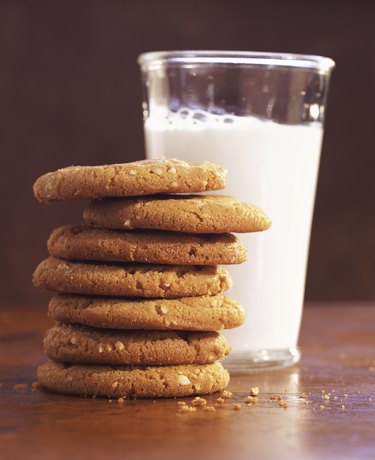
Tub butters made by whipping real butter with air or blending it with plant-based oils can support a healthy diet low in saturated fats. Although good substitutes when cooking or coating toast, tub butters won't give the desired results in crumbly baked concoctions such as cookies. Margarine products made with 80 percent fat behave most like stick butter, which by definition contains at least 80 percent milkfat, and are your best bet for butter substitutions.
Why Whipped Won't Work
Video of the Day
If your tub of butter is labeled "whipped," air pockets have been incorporated into the butter to make it easier to spread. By volume, a serving of whipped butter contains 1/3 less butter than a serving of stick butter, which means that when measuring, you end up with far less butter than you need. Other tub butters marked as "spreadable" are a 50/50 blend of regular butter and plant oils - usually canola – and result in dense, greasy cookies. Oil cannot be substituted in cookie recipes calling for butter, because oil is 100 percent fat, whereas butter also has protein and milk solids.
Video of the Day
Leave the Lite
Lite, lowfat or fat-free tubbed butters contain fillers, water and other ingredients that behave differently from the milkfat and solids in butter. Substituting with these products changes the texture and flavor of your cookies. The excess water and high moisture content of lite tub butter leaves your tasty morsels flat. Lite butter also causes cookies to spread out so thinly that they burn. This includes tubs of butter that are reduced calorie, diet and lite vegetable oil spreads.
Maximize Your Margarine
Regular margarine can be used cup for cup as a replacement for stick butter. Check the nutrition label of your butter tub to discern whether it is regular margarine. Tubs of spread labeled as margarine with 100 calories per tablespoon serving contain the required 80 percent fat that behaves the same way as stick butter. Margarine was developed in 1870 as a butter substitute. It is made by stabilizing vegetable oils – a process called hydrogenation – and results in trans fats. These fats are listed on the nutrition label and are known to have a negative impact on your blood cholesterol.
Anyone Got Applesauce?
If all you have in the refrigerator is a tub of lite butter, it might still be possible to bake that batch of cookies. Applesauce can be substituted for all or part of the fat called for in some cookie recipes. Applesauce provides extra fiber, flavor and moisture to baked goods and results in a lighter and puffier cookie. Look for recipes that use applesauce or pureed fruit such as prunes in place of butter for successful substitution.
- University of Nebraska-Lincoln Food Extension Services: Ingredient Substitutions
- North Dakota State University Extension Service: Prairie Fare: Butter vs. Margarine: What’s the Verdict?
- California Milk Advisory Board: Butter
- Baking Bites: Whipped or Light Butter in Baking
- University of California Cooperative Extension, Yolo County : Reduce Added Solid Fats - Butter, Margarine, Lard and Shortening